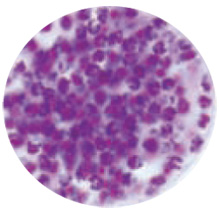This page has been archived and is being provided for reference purposes only. The page is no longer being updated, and therefore, links on the page may be invalid.
|
Read the magazine story to find out more. |
|
|
|
|
ARS Scientists Trace Toxoplasma Parasite's Family Tree
By Ann PerrySeptember 26 , 2008
Agricultural Research Service (ARS) scientist Ben Rosenthal is tracing the family tree of Toxoplasma gondii, one of the most widespread parasites of warm-blooded vertebrates. Understanding how T. gondii has evolved and disseminated will help parasitologists and public health officials improve methods for controlling the parasite in humans and animals.
Rosenthal is a zoologist at the ARS Animal Parasitic Diseases Laboratory in Beltsville, Md. He partnered with ARS microbiologist Jitender Dubey and biologist David Sibley at the Washington University in St. Louis School of Medicine to analyze DNA snippets from 46 existing T. gondii strains found around the planet.
The team concluded that all of the current types arose from a common ancestor that lived at least 10 million years ago. This one strain gave rise to four ancient groups of T. gondii — two in South America, one in North America, and one with a global distribution.
By a million years ago, the genetic material from these four ancient groups had been redistributed among 11 distinct groups of T. gondii. These 11 groups, in turn, gave rise to 46 strains found around the world today.
North and South American T. gondii populations have been evolving in almost-complete geographic isolation for one million years. But the team was surprised to find that one of the parasite's chromosomes has spread throughout the American populations within the last 10,000 years.
After studying patterns in its DNA, the scientists concluded that this genetic innovation — which they named Chr1a—probably developed in a single T. gondii strain from North America or Europe. Rosenthal hopes to learn more about why this one adaptation spread throughout the T. gondii family so quickly.
Experts believe that some 25 percent of the global human population is chronically infected with T. gondii. The parasite can cause health complications in individuals with weakened immune systems and in infants who acquire infections in utero from their infected mothers.
Read more about this research in the September 2008 issue of Agricultural Research magazine.
ARS is a scientific research agency of the U.S. Department of Agriculture.

